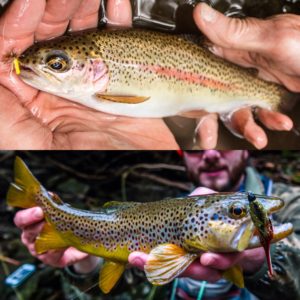Fishing ethics are subjective outside of the law. This means that we set our own standard for what we regard as sporting beyond the regulations set by state game departments; if I were to make a broad generalization about many trout fly fishermen, trout caught on flies are a pinnacle of angling and many fly anglers are specifically catch and release only, but the law may not state fly fishing as the only legal means of fishing, nor does it prohibit someone from keeping fish in most instances.

Two of Georgia’s Native fish, the Eastern Brook Trout (top) and the Coosa Bass (bottom).
Some hierarchies that vary from angler to angler can also regard size, species, or even if the fish is endemic to the region. Terms like wild, stocked, and native trout are used to differentiate tiers of hierarchies that anglers may use to influence and base their own personal ethics and fishing goals, but sometimes these terms are misunderstood or misdescribed, making it difficult to understand where ethical boundaries stand.
Stocked trout are born and raised in a hatchery and planted in a river, lake, or stream. A good way to differentiate these fish is by their fins and tail – they can be worn small from rubbing the walls and ground of the pens they are raised. Some hatcheries will also clip the adipose fin (the fin located on the back towards the tail). Even holdover trout, a stocked trout that has been in a body of water for multiple seasons or years, will have remnants of worn fins. This isn’t always the defining quality of a stocked trout – the Toccoa River is stocked with trout small enough that they can’t be differentiated from a wild trout as they grow larger and naturalize.

Two wild trout, descendants from stocked trout. (Rainbow Trout, Top. Brown Trout, Bottom)
Wild trout are born in the body of water that they reside, but these fish are not necessarily endemic or indigenous to the region like a native fish – natives naturally occur in the body of water that they are found. So, a native trout is a wild trout, but a wild trout is not always a native trout. For example, native Eastern Brook Trout are found in headwaters deep in the mountains and have been in these bodies of water for generations spanning thousands of years, but Brook trout can still be non-native fish because they are also stocked by the state in some streams. If a stocked brook trout found outside of its native range reproduces in the body of water they were planted, the offspring would be considered a wild fish, but not a native fish. This has happened in states like Colorado, outside of the normal range of the Eastern Brook Trout.
An angler may regard a wild or native trout in higher standing than stocked trout because they are historically supposed to be there, can be harder to fool, or more are more aesthetically pleasing, etc. Some anglers will gladly keep a stocked trout, but will not keep a wild or native trout. While I can’t and don’t want to tell you how you should define your own ethics, understanding what these terms mean will help you make a conscious and informed decision on what you believe and practice in your own angling endeavors.